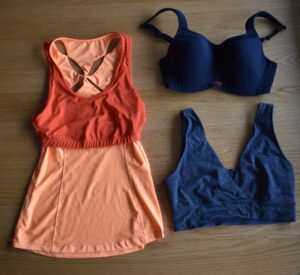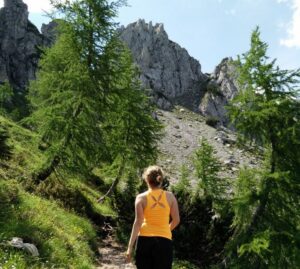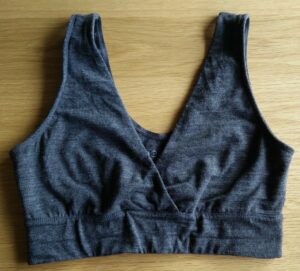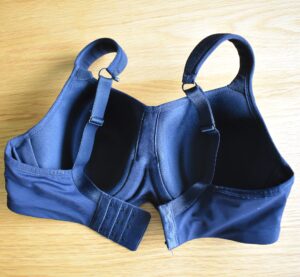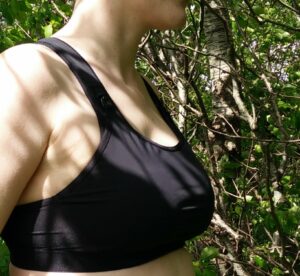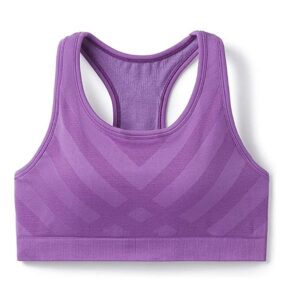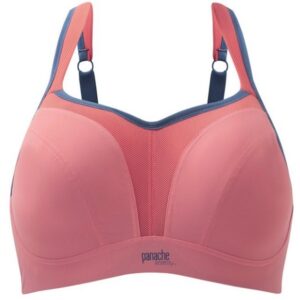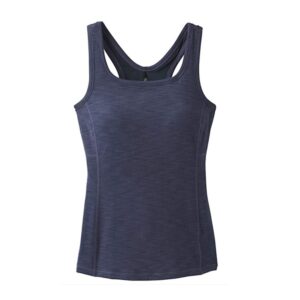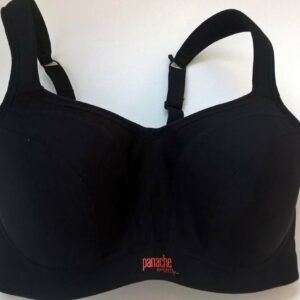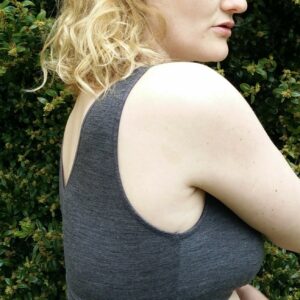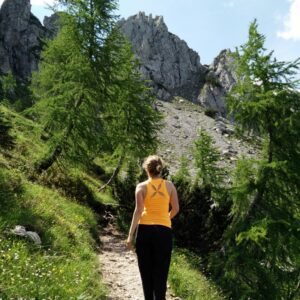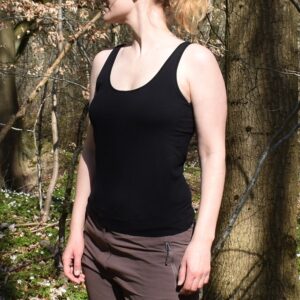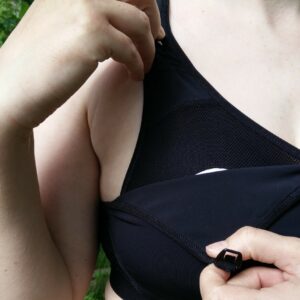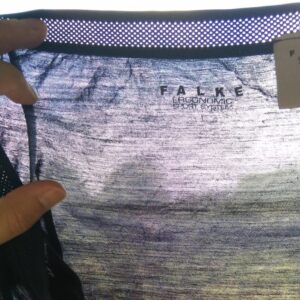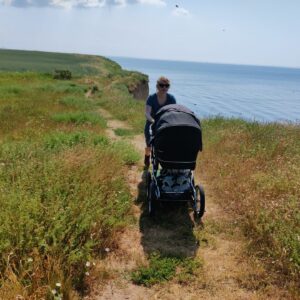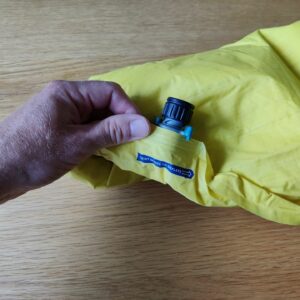For every move you make, your breasts move relatively to the torso. Depending on the activity level, your breasts will bounce in a horizontal 8-figure motion and move as much one inch for an A cup and several inches for +D-cups if you are not wearing an adequately supportive sports bra. The bounce can not only damage the soft breast tissue (thus causing drooping and sagging), but also feel so uncomfortable that it affects your performance level or even dissuade you from high intensity sports altogether, as suggested by this Australian research article. Therefore, a good sports bra is a must-have! Below you will find a brief overview as well as an in-depth discussion of the factors to consider when choosing a sports bra.
How to Choose a Sports Bra for Hiking or Trail Running: An Overview
| Small breast size (e.g. A-C cups with smaller band sizes) | Medium breast size (e.g. B-C cups with larger band sizes, D+ cups with smaller band sizes) | Large breast size (F+ cup sizes, D+ cups with larger band sizes) | |
|---|---|---|---|
| Compression sports bra | Will be good for most activities | Will only give support for low to medium impact activities | Will only give support for low impact activities |
| Encapsulation sports bra | Will be good for most activities | Depending on fit and fabric, it can provide support for medium impact activities | Depending on fit and fabric, it can provide support for low to medium impact activities |
| Encapsulation-compression sports bra | Probably not necessary | Your go-to for high-impact activities | Your go-to for high-impact activities |
Things to consider:
- Activity
- Band Width and Support Systems of Sports Bras
- Sports Bra Material
- The Straps and Back Design of a Sports Bra
- (Cup-)Size and Fitting a Sports Bra
Activity
The most important thing about a sports bra is that it supports your bosom comfortably for the type of activity you have in mind. With regards to sports bras, there are three activity levels – low impact, medium impact and high impact – which are defined by how much your bosom is likely to bounce rather than intensity. Low impact activities are walking, climbing, yoga, pilates and everyday life. Medium impact activities are more brisk walking, hiking, (some forms of) dancing and skiing. High impact activities are (trail) running, jumping and martial arts. You can of course wear a sports bra which offers more support than needed, e.g. a high-impact sports bra for medium impact activities and so forth, but not vice versa as you won’t get the required support.
Band Width and Support Systems of Sports Bras
You might have heard that the band (and not the straps!) underneath the bust accounts for as much as 70 % of the support that a sports bra offers, as it helps to keep the bosom closer to the trunk. The band should thus be relatively wide – at least 2 cm. However, it of course also matters how the bosom itself is encased to limit breast movement as much as possible. There are three different support systems: Compression, encapsulation and a combination of the two.
Compression sports bras
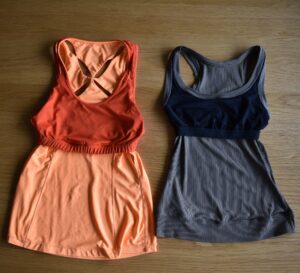
The built-in bra in a tank top is usually a liner bra. Here, Asics and Reebok tanks inside out.
The first and perhaps most commonly used support system for sports bras and tank tops with a built-in bra is the compression method, where your breasts are compressed against the chest wall by an extra layer of tight-fitting elastic fabric over the bust in unison with a broad elastic band under the bust. A compression bra can also be referred to as a shelf bra or liner bra. The tighter the band and the liner, the more support you get as the breasts are flattened against your body, thus limiting movement. If you have a small and elfin bosom, a compression bra will be good for most activities while women with larger breasts will only be supported for low to medium impact activities, and might be annoyed by perspiration and chafing between the breasts as they are pushed together rather than separated. Compression sports bras are mostly made in soft and stretchy fabrics but some of them have molded foam inserts (also called modesty pads) to give the breasts some shape and cover up potential stiff nipples.
Encapsulation sports bras
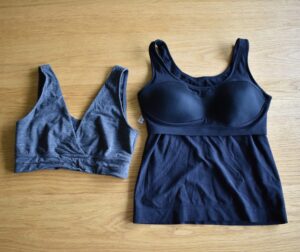
Two examples of encapsulation bras – the Boob Design bra and the FreeReign tank (inside out)
An encapsulation sports bra as such works the same way as your everyday bra as each breast is enclosed in its own cup. Most everyday bras only give support for low impact activities, but depending on the fit, material and neckline (i.e. how much of the breast is covered/enclosed by the cup) an encapsulation sports bra can give adequate support for medium impact activities too. A well-fitting high-cut encapsulation bra with molded foam cups will be more supportive than one with soft low-cut cups for the breasts. The material of the back is also important as a rigid band/back will help to limit the movement of the breasts while a soft and stretchy fabric won’t do much to keep the girls in place. An underwire will also do a lot in terms of support; encapsulation sports bras are available both with and without underwire.
Encapsulation-compression sports bras
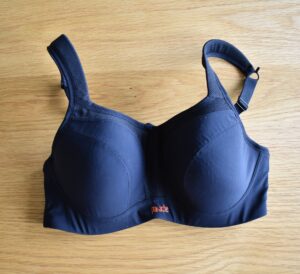
The Panache Sports bra is a great example of an encapsulation-compression bra
It is a bit hard to draw the exact line between encapsulation-compression sports bras and encapsulation sports bras (described above), but as a rule of thumb encapsulation-compression sports bras are always relatively high-cut so that each breast is fully enclosed in its own cup and thus can be efficiently compressed against the chest wall. The back will often be made of a more rigid material, or even feature a hook-and-eye closure so you can move the hook towards a tighter setting as the band loses elasticity with time and use. Encapsulation-compression bras are in general made of more rigid materials with molded foam cups etc. to limit breast movement as much as possible, and are considered to be the most supportive of all sports bras. They are thus the go-to sports bras for women with larger breasts for high impact activities while those with small bosoms have no real need for them. Encapsulation-compression sports bras come with and without an underwire.
Sports Bra Material
Unlike your everyday bra, a sports bra should be made of moisture-wicking and relatively quick-drying fabrics, so that the perspiration is wicked away from your body. The material should also feel smooth to the touch since the skin on the breasts and around your armpits can be quite sensitive. As mentioned above, the material is also important for the support level of the sports bra; rigid, denser materials will hold and support your breasts more firmly than elastic and supple fabrics. That is why (compression) sports bras made out of Merino wool rarely provide enough support for more than medium impact activities, unless you have a small and firm bosom. Sports bras are, however, most often made out of synthetic materials which can vary immensely when it comes to their moisture-wicking performance. A very supportive sports bra will often be less efficient at wicking away sweat due to the stronger and often thicker material and construction – not least because it might cover up more skin both front and back to provide the best support possible.
The Straps and Back Design of a Sports Bra
As mentioned above, it is a misconception that it is the straps that should “hold up” your breasts and comprise the majority of the support you get from a sports bra. Nevertheless, the straps and the cut of the back is not unimportant for comfort and performance, especially if for those with have larger breasts. If you have a smaller bosom, you can pick and choose between whichever design that appeals to you, but those with larger breasts might want to avoid thin straps as the straps indeed do pull some of the weight of the breasts, which can be significant.
Thin straps can dig uncomfortably into the shoulders while wider straps will ensure a better distribution of weight. Another thing to avoid if you have very large breasts is a racer back design, where the (usually) broad straps come closer to the neck than straight-up-and-down straps, which means that more weight is carried on the trapezius muscle rather than further out on the clavicle. This can cause shoulder pain if you are very well-endowed. Adjustable straps are always to be preferred for encapsulation and encapsulation-compression sports bras as they allow you to tweak the fit.
(Cup-)Size and Fitting a Sports Bra
It is bit of a myth that most women wear the wrong bra size, but even if you know your official cup size by heart (otherwise you can find a very detailed but efficient calculator here), it doesn’t mean that you will fit perfectly into exactly that size for any given brand or bra style/shape – not least because measurement systems vary internationally, and some brands even throw you a curveball by having their own proprietary systems. The best weapon you have is thus trial and error, while going through the steps below to check if the sports bra in question fits (also check out the video from British Boobydoo at the end of this section; you can skip to 2:15).
- Put the sports bra on. If it has a hook-and-eye closure, set it at the loosest setting.
- Do the scoop and swoop: Scoop each breast from the underarm and towards the middle, so they are both situated properly inside the (cups of the) sports bra. This can make a huge difference when evaluating the fit.
- Check that the band is neither too tight nor too loose: Make sure that you can run two fingers snugly between the band and your body all the way round. Also raise your arms above your head to see if the band gapes (= too loose) or rides up.
- If the shoulder straps are adjustable, you should adjust them so they feel snug and secure, but without digging into your shoulders. Again keep in mind that it is the band which should account for most of the “heavy lifting”; the straps are more for securing it.
- Now, have a critical look at how the sports bra feels and holds you in. If you are spilling out of it (front, back or both), or it is digging uncomfortably into the flesh around your armpits, or you cannot take a deep breath comfortably, it is too small and you will need a bigger (cup) size. Reversely, if the sports bra is too big, especially the cup material will pucker and crease, and the bra might gape one or more places. In that case you will need a smaller cup size and/or band size. If your breasts are different in size, look at fit for the larger one and insert a bra pad below the smaller.
- Finally, when you are satisfied with the fit of the bra, you mimic the movement of the activity you have in mind, for example brisk bouncy walking (medium impact activities) or jumping (high impact activities). If you feel comfortable and supported, you have met your match – congratulations!
Video

